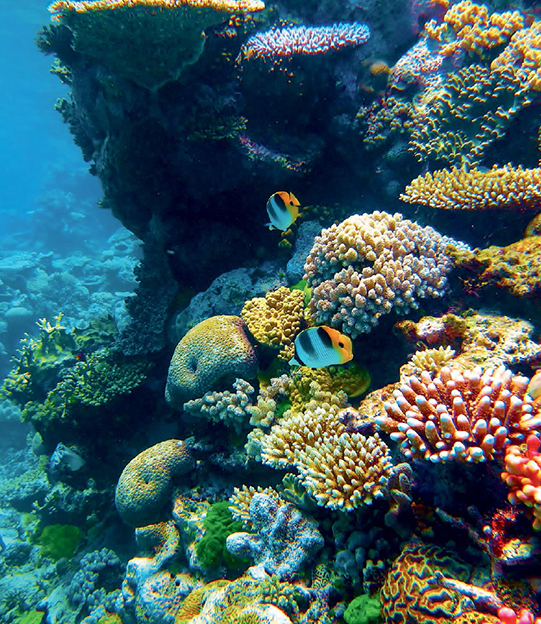1981
Great Barrier Reef
Ecologists rely on certain species of bioindicators (or indicator species) to reveal the characteristics of different parts of the environment, both in the deep past as well as in the present. For example, corals that build reefs in shallow-water colonies are highly sensitive to the temperature, salinity, and acidity of the waters in which they grow. This environmental sensitivity enables paleobiologists to reconstruct the details of ancient shallow-water oceanic environments going back to the first appearance of corals around the time of the Cambrian Explosion 550 million years ago. Even though the vast majority of coral species went extinct (along with 96 percent of all other species) about 250 million years ago during “The Great Dying” mass-extinction event at the end of the Permian era, a small fraction of coral species survived and continue to survive and serve as oceanic bioindicators today.
The largest coral reef on Earth today occurs in the Great Barrier Reef, in the shallow waters off the northeastern coast of Australia. The reef system is almost 1,400 miles (2,300 kilometers) long and is composed of thousands of individual reefs and many hundreds of small islands covering an area about the size of Germany. It is the largest single structure in the world made by living organisms. In 1975 the Australian government established the Great Barrier Reef Marine Park to recognize the special nature of this region to the nation. Perhaps more importantly, the Great Barrier Reef was elevated to a United Nations World Heritage Site in 1981 in recognition of its global status as a unique and special ecosystem in need of constant protection.
Corals provide a perfect example of endosymbiosis, as they rely on algae and other organisms to provide energy via photosynthesis and to help with the calcification that enables reefs to grow. However, because of rising ocean temperatures, overfishing, ocean acidification, and pollution, corals worldwide are suffering because they are unable to provide adequate amounts of CO2 and other nutrients for the algae, breaking down the symbiotic relationship. The result is “bleaching” (whitening) of corals worldwide as the algal population decreases, leading eventually to the slow starvation and death of the corals themselves. Corals can recover from bleaching, but perhaps not without our (worldwide) help.
SEE ALSO Earth’s Oceans (c. 4 Billion BCE), Cambrian Explosion (c. 550 Million BCE), The Great Dying (c. 252 Million BCE), Geology of Corals (1934), Exploring the Oceans (1943), Endosymbiosis (1966), Oceanography from Space (1993), Ocean Conservation (1998)
A 2014 photo of shallow-water tropical corals and fish at Flynn Reef in the Great Barrier Reef Marine Park, off the coast of Queensland, Australia.
